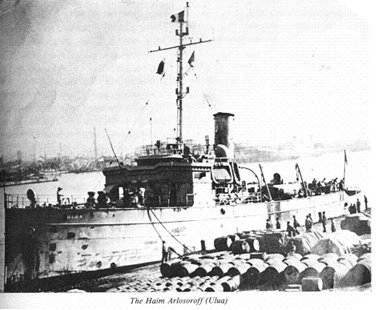I was born in Montreal, Canada, on 30th October 1924. I was a member of the Habonim youth movement in Toronto before joining the Canadian Armed Forces late in 1943. I was trained as an air gunner and wireless operator, but by the time I was ready to go overseas to fight, the war had ended with the defeat of Germany and Japan.
After that, I was recruited by a Haganah emissary in Toronto in 1946 and joined Aliyah Bet, and that is how the story began. I proceeded to New York, staying at the Breslin Hotel until receiving word to travel to Baltimore to join the “Ulua” (Chaim Arlosoroff), where I met the rest of the crew. We outfitted the 1000-ton ship and left for Marseilles through Chesapeake Bay, Cape Hatteras and then crossed the Atlantic. It was a bad trip: I was seasick most of the time, but still had to work. We spent about six weeks in Marseilles outfitting the ship with bunks three-high and then left for Denmark and across to Trelleborg in Sweden, where 600 single girls and a few men awaited our arrival; they had been rescued from the concentration camps. What a sight it was; a train pulled up to our dock and these well-dressed women came on board. When they went below and saw the three-tiered bunks, they panicked, recalling their concentration camp days.
We left after an emotional farewell with friends on the dock, and the girls on board singing the Swedish national anthem. We sailed to Le Havre to take on more fuel and provisions. The British asked the French to prevent out ship from leaving, so we left in the middle of the night after cutting our lines. After a bad storm in the Bay of Biscay we finally got through Gibraltar to the Mediterranean. We passed a British flotilla carrying the royal family to South Africa. They asked for our colors, so we raised the Magen David flag since BBC broadcasts had been tracking our progress. We went across to Tangier and hid in a cove for two days, and then we crossed the Mediterranean to Italy. A few days later we hit Monteponto in the Gulf of Taranto in Italy, where we used our longboats and pulled ourselves ashore on a wire anchored to the shore and took on another 700 refugees. What a night. We lost nobody due to a few miracles.
We then set out for Palestine. A day out of Haifa we were surrounded by five or six British warships. They proceeded to jump us, but we took evasive action and tore the side of one of the British frigates. Eventually they tear-gassed the whole ship and managed to land many marine commandos and the infamous “Calaniot.” They took over the ship, but they couldn’t stop us from running our ship up onto the beach at Bat Galim. We were dragged off onto prison ships. The “Empire Lifeguard” was the one I was on, and we were deported to Cyprus, where we met the other thousands of Jews interned there.

Reproduced from “The Jews Secret Fleet” with the kind permission of author Murray S. Greenfield
In Cyprus the British were very proper and correct, and let us run the camp ourselves. The few soccer games we had with the British usually ended up in a riot. If one had to have enemies, I was glad it was the British with their concept of fair play. Our relationships with the illegal immigrants were very warm and some close friendships were formed. We were young and the women were young, and they thought we were great Jewish heroes and treated us accordingly. We met some of them after we came back to fight in 1948 and to this day I still see some of them.
These people, survivors of the death camps, only wanted to go to a home for Jews. They rejected chances of going elsewhere. To my dying day I will never forget these fellow Jews: I was so proud to be one of them. Eventually I was able to escape to Palestine, spending a few months there and then back to Canada to help recruit the first Canadian volunteers to fight in 1948.
I returned to Palestine in April 1948 with Canadian Machal, and joined the army to fight at Latrun (on three different occasions) and then went on to join the navy after the first ceasefire, where I served on the “Wedgwood,” which had been converted into a warship. We fought off Egyptian ships trying to attack Tel Aviv port, shot down an Egyptian Dakota bomber and sailed into Tyre in Lebanon, and shot up the port. After the next ceasefire I joined the air force, training as a flight controller at Akir, and spent the rest of the war until April 1949 in charge of the Beersheba air strip.
Author: Ben Ocopnick
This story is reprinted with the kind permission of the Palyam website: www.palyam.org

